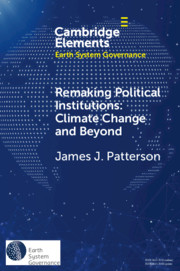35 results

Remaking Political Institutions: Climate Change and Beyond
-
- Published online:
- 31 December 2020
- Print publication:
- 04 February 2021
-
- Element
-
- You have access
- Open access
- HTML
- Export citation
1 - Introduction: Agency in Earth System Governance
- from Part One - Introduction and Overview
-
-
- Book:
- Agency in Earth System Governance
- Published online:
- 04 January 2020
- Print publication:
- 02 January 2020, pp 3-24
-
- Chapter
- Export citation
8 - Agency and Architecture: Producing Stability and Change
- from Part Two - Agency and the Dynamics of Earth System Governance
-
-
- Book:
- Agency in Earth System Governance
- Published online:
- 04 January 2020
- Print publication:
- 02 January 2020, pp 97-107
-
- Chapter
- Export citation
15 - Conclusion: Policy Implications of ESG–Agency Research and Reflections on the Road Ahead
- from Part Three - Policy Implications and the Future of Agency in Earth System Governance Research
-
-
- Book:
- Agency in Earth System Governance
- Published online:
- 04 January 2020
- Print publication:
- 02 January 2020, pp 183-197
-
- Chapter
- Export citation
12 - Agency and Adaptiveness: Navigating Change and Transformation
- from Part Two - Agency and the Dynamics of Earth System Governance
-
-
- Book:
- Agency in Earth System Governance
- Published online:
- 04 January 2020
- Print publication:
- 02 January 2020, pp 143-154
-
- Chapter
- Export citation
3 - Empowerment and Disempowerment of Urban Climate Governance Initiatives
-
-
- Book:
- Urban Climate Politics
- Published online:
- 29 April 2019
- Print publication:
- 09 May 2019, pp 39-58
-
- Chapter
- Export citation
The prevalence and treatment outcomes of antineuronal antibody-positive patients admitted with first episode of psychosis
-
- Journal:
- BJPsych Open / Volume 4 / Issue 2 / March 2018
- Published online by Cambridge University Press:
- 16 March 2018, pp. 69-74
-
- Article
-
- You have access
- Open access
- HTML
- Export citation
Effects of Insecticide, Weed-Free Period, and Row Spacing on Soybean (Glycine max) and Sicklepod (Cassia obtusifolia) Growth
-
- Journal:
- Weed Science / Volume 32 / Issue 5 / September 1984
- Published online by Cambridge University Press:
- 12 June 2017, pp. 702-706
-
- Article
- Export citation
Invasion Dynamics and Genotypic Diversity of Cogongrass (Imperata cylindrica) at the Point of Introduction in the Southeastern United States
-
- Journal:
- Invasive Plant Science and Management / Volume 1 / Issue 2 / April 2008
- Published online by Cambridge University Press:
- 20 January 2017, pp. 133-141
-
- Article
- Export citation
Resurrecting the chimera: Progressions in parenting and peer processes
-
- Journal:
- Development and Psychopathology / Volume 28 / Issue 3 / August 2016
- Published online by Cambridge University Press:
- 18 July 2016, pp. 689-706
-
- Article
- Export citation
Applying Pattern Recognition to the Analysis of X-ray Computed Tomography Data of Polymer Foams
-
- Journal:
- Microscopy and Microanalysis / Volume 22 / Issue S3 / July 2016
- Published online by Cambridge University Press:
- 25 July 2016, pp. 104-105
- Print publication:
- July 2016
-
- Article
-
- You have access
- Export citation
Contributors
-
-
- Book:
- Silverberg's Principles and Practice of Surgical Pathology and Cytopathology
- Published online:
- 13 March 2015
- Print publication:
- 26 March 2015, pp vii-x
-
- Chapter
- Export citation
Chapter 8 - Cutaneous tumors and tumor-like conditions
-
-
- Book:
- Silverberg's Principles and Practice of Surgical Pathology and Cytopathology
- Published online:
- 13 March 2015
- Print publication:
- 26 March 2015, pp 363-456
-
- Chapter
- Export citation
Contributors
-
-
- Book:
- Parasite Diversity and Diversification
- Published online:
- 05 March 2015
- Print publication:
- 26 February 2015, pp viii-xii
-
- Chapter
- Export citation
Contributors
-
-
- Book:
- Essential Clinical Anesthesia Review
- Published online:
- 05 February 2015
- Print publication:
- 08 January 2015, pp xi-xvi
-
- Chapter
- Export citation
Does Tolstoy's War and Peace Make Modern War Literature Redundant?
- from III - AFTERMATHS
-
- Book:
- War and Literature
- Published by:
- Boydell & Brewer
- Published online:
- 05 October 2014
- Print publication:
- 16 October 2014, pp 228-248
-
- Chapter
- Export citation
Contents
-
- Book:
- War and Literature
- Published by:
- Boydell & Brewer
- Published online:
- 05 October 2014
- Print publication:
- 16 October 2014, pp v-vi
-
- Chapter
- Export citation
List of Illustrations
-
- Book:
- War and Literature
- Published by:
- Boydell & Brewer
- Published online:
- 05 October 2014
- Print publication:
- 16 October 2014, pp vii-vii
-
- Chapter
- Export citation
Acts of Vengeance, Acts of Love: Crusading Violence in the Twelfth Century
- from I - IDEOLOGIES
-
- Book:
- War and Literature
- Published by:
- Boydell & Brewer
- Published online:
- 05 October 2014
- Print publication:
- 16 October 2014, pp 3-20
-
- Chapter
- Export citation
‘Is this War?’: British Fictions of Emergency in the Hot Cold War
- from I - IDEOLOGIES
-
- Book:
- War and Literature
- Published by:
- Boydell & Brewer
- Published online:
- 05 October 2014
- Print publication:
- 16 October 2014, pp 41-58
-
- Chapter
- Export citation



